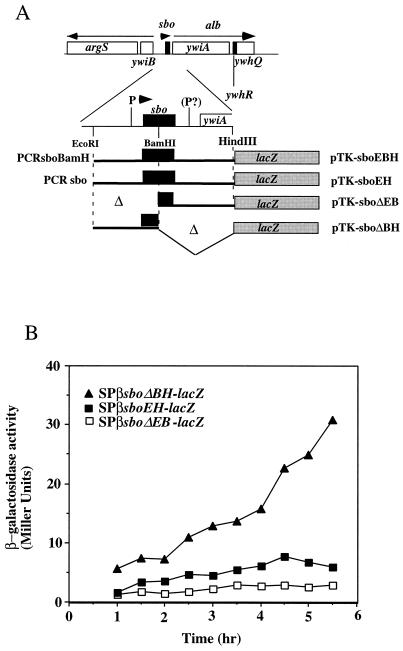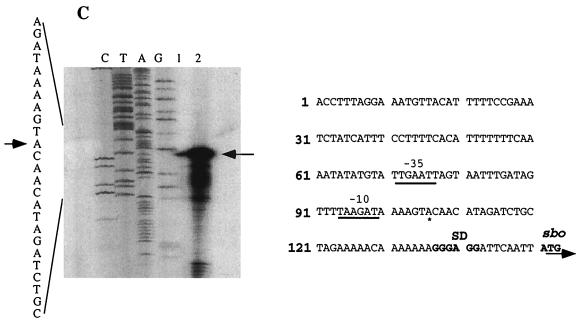FIG. 6.
(A) A fragment containing the sbo gene and the 5′ end of the alb operon was obtained by PCR and inserted into the promoter probe plasmid pTKlac (24). The EcoRI-BamHI fragment bearing the putative sbo promoter region was deleted to create an alb-lacZ (sboΔEB-lacZ) fusion, and the BamHI-HindIII fragment was deleted to create an sbo-lacZ (sboΔBH-lacZ) fusion. Additionally, the EcoRI-HindIII fragment containing the entire sbo gene and flanking DNA was inserted into pTKlac to create sboEH-lacZ, while the fragment containing the PCR-generated sboEBH allele was inserted into pTKlac to create the sboEBH-lacZ construct. The fusions thus constructed were inserted into the SPβ prophage of B. subtilis, using a published protocol. (B) Expression of the phage-borne fusions in cells of strains ORB3158 (SPβsboΔEB-lacZ), ORB3162 (SPβ–sboΔBH-lacZ), and ORB3166 (SPβsboEH-lacZ) grown in DSM-G. T0, the time at which exponential growth ceases, is indicated by an arrow. (C) Primer extension analysis of RNA from JH642 and ZB449 (abrB703) cells. RNA was purified from cells of cultures grown to T2 in DSM-G. On the left is the autoradiograph showing the sequence pattern of a dideoxynucleotide sequencing reaction containing primer osboP4 and pTK-sboEH DNA. Lane 1, primer extension product from a reaction containing JH642 RNA and the osboP4 oligonucleotide; lane 2, primer extension product of the reaction of ZB449 RNA and osboP4 primer. The arrow indicates the primer extension products and the proposed start site of transcription in the sequence at the left. On the right is the nucleotide sequence of the sbo promoter region, with the ATG start codon and Shine-Delgarno (SD) sequence shown. The putative −10 and −35 regions of the sbo promoter are underlined. An asterisk marks the transcriptional start site.


